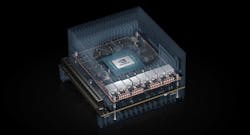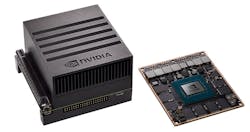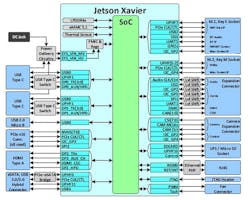NVIDIA’s Jetson series of compact compute engines is impressive, starting with the TX1 and followed by the TX2. Its latest addition is the Jetson AGX Xavier (Fig. 1). It uses a new form factor and connector that differs from the TX1 and TX2—the connection now allows for more functionality. The software package for the Xavier is compatible with the older platforms, but it’s been expanding. These changes are why I’m presenting the Jetson AGX Xavier in a multipart series, kicking off with an examination of the hardware.
1. The NVIDIA Jetson AGX Xavier development kit includes a compact carrier board and the Jetson Xavier module and heat sink.
Like the TX1 and TX2, the Xavier is a module that’s available with a carrier board for development purposes. The development board for the TX1 and TX2 was larger to expose its array of peripherals. Developers were required to download and install the initial software, whereas the Xavier comes with software installed.
The Jetson AGX Xavier module features its own heatsink and fan (Fig. 2). The module also has 32 GB of eMMC 5.1 flash storage and 16 GB of LPDDR4, as well as on-board power management.
2. The Jetson AGX Xavier module includes NVIDIA’s system-on-chip, eMMC storage, LPDDR4 memory, and power-management support.
The carrier board exposes the module interfaces including gigabit Ethernet, 8-lane PCI Express (PCIe) Gen 4, an SD/UFS socket, eSATAp with USB 3.0 Type A support, two USB 3.1 Type-C connectors, 16 CSI-2 camera lanes, HDMI 2.0, eDP 1.2a, and DP 1.4, plus high-definition audio. A 40-pin header provides access to UART, SPI, CAN, I2C, I2S, DMIC, and GPIOs. The x8 PCIe interface is connected to a PCIe socket.
The carrier board has a full-length M.2 Key M with NVMe x4 support and a short M.2 Key E that has PCIe x1, USB 2.0, UART (for Wi-Fi/LTE), I2S, and PCM support. The former is for storage while the latter tends to be used for wireless interfacing. The M.2 Key M socket is significant because it allows faster NVMe storage to replace the more limited eMMC support on the module.
The 350-mm2 Xavier (Fig. 3) system-on-chip (SoC) packs 9 billion transistors and is fabricated on TSMC’s 12-nm process (12FFN). The processing core consists of NVIDIA’s 64-bit Carmel cores based on ARM’s ARMv8 architecture. Eight cores are combined in four duplex clusters. The cache-coherent fabric connects the CPU cluster with the GPU and other accelerators.
3. Among the features of the Jetson AGX Xavier system-on-chip are 64-bit ARMv8 cores, the Volta GPU, a deep-learning accelerator (DLA) and the programmable vision accelerator (PVA). (Annotated by WikiChip)
The Volta GPU includes eight Volta stream multiprocessors that have access to the 512-kB shared L2 cache. The 512 CUDA Tensor cores support INT8 as well as FP16 operations. The system can deliver 22.6 INT8 TOPS. The system also maintains encode and decode hardware support for 12-bit, dual-channel 4Kp60 video streams.
The Volta GPU can be used for video and machine-learning (ML) chores, but it’s also augmented with an image signal processor (ISP), a multimedia engine, a pair of programmable vision accelerators (PVAs), and a pair of NVIDIA deep-learning accelerators (NVDLAs). The PVA, a 7-way VLIW processor, can be used to implement common filters and detection algorithms such as Harris corner. The NVDLA delivers 5.7 FP16 FLOPS or 11.4 INT8 TOPS. These accelerators can be used in parallel or in conjunction with the CPU and GPU cores.
The kit is priced at $1,299.
The system comes with Ubuntu Linux installed on the eMMC memory. Also included are a number of NVIDIA tools like cnDNN, TensorRT, and DeepStream SDK support, but more on that in the next article. The development kit is designed to be usable right out of the box.
The hardware alone is impressive. It delivers 20X the performance and 10X the power efficiency of the Jetson TX2. It targets applications such as self-driving vehicles as well as robotics where image-processing and machine-learning acceleration is a valuable feature. The larger size may limit its use in smaller drones, but it can be very useful in drones that allow for a higher payload weight.
The Jetson AGX Xavier is designed for ML applications on the edge where interference is the norm. The platform actually has enough performance for hosting development especially when storage is expanded using the M.2 NVMe socket or network-based storage. The PCIe socket could also be used for additional storage, although it’s more likely to be employed for application hardware or additional accelerators.
The platform is designed for ISO 26262 and ASIL-C environments, and includes enhanced security support. Overall, an impressive chunk of hardware in a very compact package.
About the Author
William G. Wong
Senior Content Director - Electronic Design and Microwaves & RF
I am Editor of Electronic Design focusing on embedded, software, and systems. As Senior Content Director, I also manage Microwaves & RF and I work with a great team of editors to provide engineers, programmers, developers and technical managers with interesting and useful articles and videos on a regular basis. Check out our free newsletters to see the latest content.
You can send press releases for new products for possible coverage on the website. I am also interested in receiving contributed articles for publishing on our website. Use our template and send to me along with a signed release form.
Check out my blog, AltEmbedded on Electronic Design, as well as his latest articles on this site that are listed below.
You can visit my social media via these links:
- AltEmbedded on Electronic Design
- Bill Wong on Facebook
- @AltEmbedded on Twitter
- Bill Wong on LinkedIn
I earned a Bachelor of Electrical Engineering at the Georgia Institute of Technology and a Masters in Computer Science from Rutgers University. I still do a bit of programming using everything from C and C++ to Rust and Ada/SPARK. I do a bit of PHP programming for Drupal websites. I have posted a few Drupal modules.
I still get a hand on software and electronic hardware. Some of this can be found on our Kit Close-Up video series. You can also see me on many of our TechXchange Talk videos. I am interested in a range of projects from robotics to artificial intelligence.





